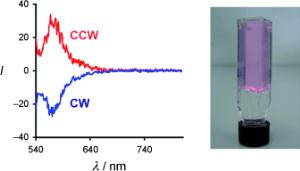
|
Sucked into the vortex: Hydrogels with embedded Rhodamine B dye showed stir-induced circularly polarized luminescence (CPL; see picture), the sense of which can be controlled by switching the stir direction from clockwise (CW) to counterclockwise (CCW) with slow cooling from the sol to gel states. The chiral alignment of the dye was erased by heating the sample above the gel–sol transition temperature.
[Credit: Angewandte Chemie International Edition] |
Light can also be viewed as a wave. The oscillation of ordinary light from a light bulb has no preferred direction. It varies in all directions perpendicular to the direction of propagation of the light. As the two trees do with the rope, special glasses, known as polarizing filters, allow only those light waves which oscillate in a specific plane to pass through. The light that passes through is known as linearly polarized light. Another variation is also possible: circularly polarized light. In this case, the light wave oscillates in a helical pattern because the amplitude describes a circle around the axis of propagation. The amplitude can rotate around to the left or the right.
The shape and orientation of molecules can influence the polarization plane of light when it passes through a given substance. It is thus not surprising that some molecules that emit light (luminesce) can give off polarized light. This luminescence can be circularly polarized if the emitting molecules (luminophores) are arranged helically.
The Japanese researchers from the Tokyo University of Science and the Nara Institute of Science and Technology have now found a new twist for emitting circularly polarized light: simply stir. Why does this work? Stirring causes spiral vortexes to form in liquids, which can induce the luminophores to adopt a helical arrangement.
The researchers were even able to preserve the forcibly twisted directionality of the luminescence by causing the solution containing the luminophore molecules, a green rhodamine dye, to gel while being stirred. A gel is formed like the gelatine glaze on a cake. Below a certain temperature the molecules of a gelling agent form a loose network with cavities that contain the other components of the liquid. If the dye solution with a suitable gelling agent is cooled under stirring, the stir-induced spiral arrangement of the luminophores is maintained in the gel. Depending on the direction of stirring, the gel emits left- or right-polarized luminescence. Without stirring, the light emitted is not polarized.



